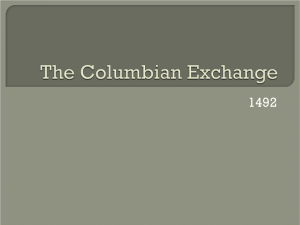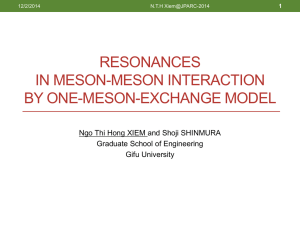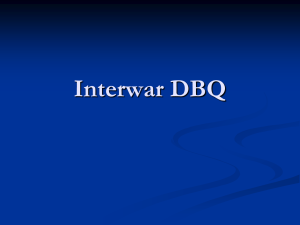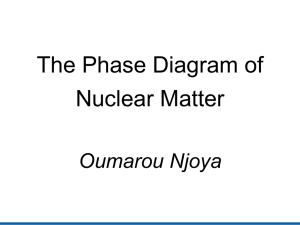Juan Nieves
advertisement
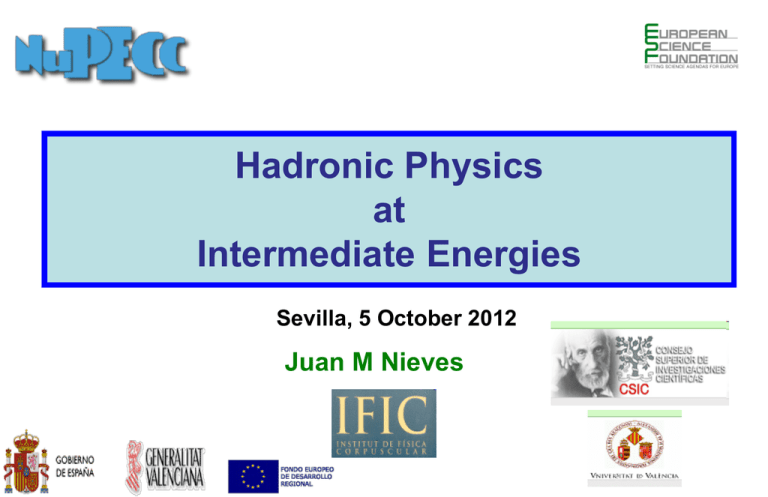
Hadronic Physics at Intermediate Energies Sevilla, 5 October 2012 Juan M Nieves Hadron physics aims at understanding the properties of hadrons and their mutual interactions from QCD (the theory governing the dynamics of quarks, the constituents of hadrons). This is an ambitious goal and the field is compartmented into several subfields that basically study the phases and structures of QCD at their various levels of complexity. EXPERIMENTS BNL, RHIC Jlab MiniBooNE, Minerna BaBar, CLEO KEK JPARC T2K BELLE, BES DaFne-Frascati MAMI-Mainz, ELSA-Bonn HADES COMPASS COSY-JÜLICH GSI-FAIR . . . Typical topics in hadron physics: Chiral Perturbation Theory Effective Field Theory Baryon Resonance Structure and Quark Models Exotic Hadrons Hadron Properties from Lattice QCD Spectroscopy of light and heavy quark hadrons Quarkonia Glueballs, hybrids and multiquarks Hadrons in matter Heavy ion collisions . . . The spanish theory groups have been and are very active in contributing to the progress of Hadron physics. The groups are well integrated in the international circuit, participating in the big european projects (e.g. HadronPhysics) and providing support to the ongoing and future experiments, with an especial focus to the FAIR physics program. The experimental groups working on hadron physics projects are very limited. However, many spanish citizens are involved in experimental collaborations (MAINZ, GSI, CERN, …) and could be the seed for an eventual growing of the experimental groups. Activity integrated in Hadron and Nuclear Physics group (UNIVERSITY OF BARCELONA) Members: permanent: Assumpta Parreño, Artur Polls, Àngels Ramos other: Volodymyr Magas (RyC), Emmanuel Chang (postdoc), Estela Jiménez-Tejero (doc) , Axel. Pérez-Obiol (doc) Topics: Hadron-Hadron interactions (with effective chiral lagrangians and lattice QCD simulations) Hadron spectroscopy (with light and heavy flavors) Hadron production with EM probes Hypernuclear physics Hadrons in the nuclear medium at finite temperature Relativistic Heavy Ion Collisions Collaborations: ICE (CSIC), ICFO (Barcelona) Valencia,Granada,Murcia, Groningen,GSI,Bergen,Kiev,Torino,USA (NPLQCD nodes), La Plata (V.K. Magas, L. Roca) Hadrons in the medium Hartmann et al., PRC85 (12) 035206 η' N scattering at low energies and in-medium η' width from γA->η'A' reactions E. Oset and A. Ramos, Phys.Lett. B704 (2011) 334-342 M. Nanova et al, Phys.Lett. B710 (2012) 600-606 The in-medium Φ meson width has been studied via proton induced Φ production in different nuclei (C, Cu, Ag and Au) using ANKE detector system at COSY The η'N interaction is studied within a chiral unitary approach, including the coupling of baryons to a singlet SU(3) meson. Predictions are compared with a recent measurement of the in-medium η' width by the CBELSA/TAPS collaboration Nuclear medium effects on the K* meson The decay width of the K*ˉ vector meson in matter at saturation density is five times bigger than in free space. It could be studied from the transparency ratio in the γ A-> K+ K*ˉ A′ reactions Charm mesons in nuclear matter at finite temperature L. Tolós, R. Molina, E. Oset, A. Ramos, PRC82 (2010) 045210, NPA881 (2012) 169-177 The properties of open charm mesons, D+, Dˉ, Ds+ and Dsˉ, in nuclear matter at finite temperature for the conditions of PANDA and CBM@FAIR are studied within a coupled channels model C.E. Jimenez-Tejero, A. Ramos, L. Tolós, I. Vidaña, Phys.Rev. C84 (2011) 015208 Weak |DS|=1 baryon-baryon interaction. Hypernuclear decay Lowest-order contribution to the weak LN → NN diagram A. Pérez-Obiol, A. Parreño, B. Juliá-Díaz Phys .Rev. C84 (2011) 024606 Resonance saturation for the L N → N N transition The relative importance of the different exchange mechanisms included in the meson picture is extracted by means of a comparison to the corresponding operational structures appearing in the effective field theory approach Microscopic approach to the proton asymmetry in the nonmesonic weak decay of Λ-hypernuclei The weak decay of polarized hypernuclei is studied including 1-nucleon , 2-nucleon induced decays and Final State Interactions E. Bauer, G. Garbarino, A. Parreño and A. Ramos Phys.Rev. C85 (2012) 024321 Effective Theories of the Strong Interactions. Applications to heavy quarkonium physics and to QCD under extreme conditions. Project: FPA2010-16963 (IFAE-UAB, IEEC-CSIC, UB) Members permanent: Cristina Manuel (IEEC-CSIC), Antonio Pineda (IFAE,UAB) and Joan Soto [PI] (UB), Nora Brambilla (TUM), Antonio Vairo (TUM) other: Laura Tolos (RyC, IEEC-CSIC), Jaume Tarrus (postdoc, UB), Miguel Ángel Escobedo (postdoc, TUM), Maximilian Stahlhofen (doc, UWien), Olena Romanets (doc, KVI), Eduard Bosch (doc,UBUniv.Frankfurt) Topics: Heavy Quarkonium QCD at finite temperature and/or density Non-relativistic effective theories for nucleons and pions Quark-hadron duality in EFTs EFT for strongly coupled superfluids Collaborations: INFN(Gran Sasso), Univ. Frankfurt, FIAS, Univ. Granada, Univ. Barcelona, IFIC/Univ. Valencia, Univ. Groningen, Univ. Regensburg,.. Framework and Scientific Goals Framework: QCD, the current theory of strong interactions Related to experiments at CERN (LHCb, ALICE), Brookhaven (RHIC), KEK (Belle) and GSI (PANDA and CBM at FAIR), among others Tools: Effective Field Theories (EFT) Systems: • Heavy Quarkonium • QCD at finite temperature and/or density • Nucleons and pions • Superfluids Summary of Activities Heavy Quarkonium “Effective field theory for ultrasoft momenta in NRQCD and NRQED”, Pineda and Soto, Nucl. Phys. Proc.Suppl.64: 428-432, 1998 “Effective field theories for heavy quarkonium”, Brambilla, Pineda, Soto and Vairo, Rev.Mod.Phys.77: 1423, 2005 • Perturbative calculations in pNRQCD • Non-perturbative calculations in pNRQCD • Production in NRQCD QCD at finite temperature and/or density “Semiclassical transport theory for nonAbelian plasmas”, Litim and Manuel, Phys.Rept.364: 451-539, 2002 “Mutual friction in a cold color flavor locked superfluid and r-mode instabilities in compact stars, Mannarelli, Manuel and Sa’d, Phys.Rev.Lett.101: 241101, 2008. “Charmed and strange baryon resonances with heavy-quark spin symmetry”, Romanets, Tolos, Garcia-Recio, Nieves, Salcedo and Timmermans, Phys.Rev.D 85: 114032, 2012 Finite Temperature: Description of the matter created in Heavy-Ion Collisions Renormalization Group at finite temperature Heavy Quarkonium in the quark-gluon plasma Finite Density: Quark Matter Charm and Charmonium Strangeness Physics of compact stars Non-relativistic effective theories for nucleons and pions “Effective Field Theory with Dibaryon Fields: Nucleon-Nucleon amplitudes at NNL”, Soto and Tarrus, Phys.Rev.C81: 014005, 2010. Quark-hadron duality in EFTs “Deep inelastic scattering and factorization in the ’t Hooft Model”, Mondejar and Pineda, Phys.Rev.D79 :085011,2009. Superfluids: EFT for strongly coupled superfluids “Shear viscosity due to phonons in superfluid neutron stars”, Manuel and Tolos, Phys.Rev. D 84: 123007, 2011 “Shear viscosity in a superfluid cold Fermi gas at unitarity”, Mannarelli, Manuel and Tolos, arXiv:1201.4006 “Bulk viscosities for cold Fermi superfluids close to the unitary limit”, Escobedo, Mannarelli and Manuel, Phys.Rev.A79: 063623, 2009. “Effective field theory and dispersion law of the phonons of a non-relativistic superfluid”, Escobedo and Manuel, Phys. Rev. A 8: 023614, 2010 Our aim is to study different issues of current interest in heavy quarkonium physics and in QCD at finite temperature and/or density, together with applying EFT techniques for strongly interacting systems such as nucleons and pions, and superfluids Nuclear and Hadron Physics at Intermediate Energies (UNIVERSITY OF SEVILLA) Members: permanent: J.A. Caballero other: R. González (doc) Topics: Lepton nucleus scattering (scaling, meson-exchange currents…) Nucleon form factors and medium effects Colaborations: Madrid, Granada, Torino, Pavia, Lecce, Sofia, MIT Electroweak Reactions at Intermediate Energies • • • • • • Beyond the Impulse Approximation: MEC, 2p-2h contributions, … Electron scattering on few-body systems: 3-He, 4-He Relativistic analyses of electron & neutrino scattering reactions Scaling phenomenon in lepton scattering Parity violation in electron scattering: strangeness in the nucleon MiniBooNE Collaboration,… Colaboración con UCM y UGR Universality of the scaling function: it can be used to predict neutrino-nucleus cross sections. Essential to analyze neutrino oscillations: MiniBooNE, Minos, K2K. Nuclear and Hadronic physics at intermediate energies (UNIVERSITY OF GRANADA) Members: permanent: E. Amaro, C. García-Recio, J. E. Romera, E. Ruiz-Arriola, L.L. Salcedo other: Rodrigo Navarro (doc), Ignacio Ruiz-Simo (posdoct) Topics: Hadron-Hadron interactions (chiral symmetry, non-perturbative metods…) QCD effective action and chiral quark models Hadronic systems in a dense medium at finite temperature Dispersion of electroweak probes off nuclei (hadron production or quasielastic scattering) Hypernuclear physics Non-linear quantum dynamics in atoms, molecules and nuclei Collaborations: Valencia, Salamanca, UCMadrid, Barcelona, Sevilla, Cracow,Torino,Jülich, Bonn, Frankfurt, MIT, Ohio, BNL, Idaho D-nucleus bound states, C. García-Recio, J. Nieves, L.L. Salcedo and L. Tólos, PRC 85, 025203 (2012) Nuclear Physics Group GFN-UCM (Complutense University Madrid) Members: Permanent: E. Moya de Guerra, J. Retamosa, J.M. Udías Postdocs: C. Fernández-Ramírez (JdlC), A. Relaño (Lecturer), L. Muñoz (Assistant Lecturer), O. Moreno (Assistant Lecturer) Topics: Nuclear effects in neutrino-nucleus interactions at intermediate energies Spectral fluctuations of the hadronic mass spectra Pion production with EM probes Structure of the nucleons: strange content, form factors Main Collaborations: Sevilla, Granada, MIT, Torino, JLab, Mainz Electron scattering of nucleons bound on nuclei Experimental study performed at JLAB and MAMI in order to identify possible modifications of the nucleon structure inside the nuclei. UCM contribution: development and extension of a realistic relativistic modeling of the reaction, incorporating it into the MC tool and making possible the data analysis ratio of GE/GM form factors in bound nucleons, Data from JLAB and MAMI, FSI are constrained by induced polarization measurement Data suggests the pressence of mild medium modifications of the form factors, like the ones implied in QMC model Several publications co-authored with the Hall A collaboration of JLAB, about polarization transfer in the 4He((e,e 'p)3H reaction, PRL106, (2011) 052501, PRL 105, 072001 (2010), PRL 91, 052301 (2003) • Chaos in hadrons: Application of spectral statistical techniques inherited from Quantum Chaos to the experimental meson and baryon spectra. Both meson and baryon spectrum happen to be chaotic [PRL 98, 062001 (2007); PLB 710, 139 (2012)], incompatible with most theoretical approaches which provide integrable spectra. Meson model by Vijande et al. JPG 31, 481 (2005) is the only one with spectralstatistic properties close to the experimental spectrum. • Photoproduction of pions in the resonance region and on nuclei: Ann. Phys. 321, 1408 (2006); PLB 664, 57 (2008); PRC 77, 065212 (2008); PLB 660, 188 (2008) • Near threshold pion photoproduction: Accurate test of chiral symmetry: Working on both the experimental (A2 and CB-TAPS collaborations at Mainz) and theoretical sides, PLB 679, 41 (2009); PRC 80, 065201 (2009) Effective Theories in Modern Physics Dept. Theoretical Physics I & II) (UNIVERSITY COMPLUTENSE OF MADRID: Members: permanent: A. Dobado, F.J. Llanes-Estrada, A. Gómez-Nicola, J.R. Peláez other: D. Cabrera (posdoct), I. Scimeni (RyC), J. Nebreda (recent doc), G.Rios (recent doc), J. Torres-Rincón (recent doc), J. Ruiz de Elvira (doc), R. Torres Andres (doc), M. Echevarria (doc), O. Pavlova (doc) Topics: Efective Field Theories (ChPT and SCET) Hadron-Hadron Interactions, hadron spectroscopy, structure and decays (light and heavy) Structure of matter in neutron stars Hadrons in the nuclear medium at finite temperature and Relativistic Heavy-Ion Collisions. Collaborations: Bahia,Bonn-Jülich,Cracovia,Graz,GSI,Indiana,ITEP-Moscú,Lisboa,Minnessotta,MIT,Murcia Grants during 2012: Spanish-FPA (2 coordinated projects), Hadron Physicss2 (European-FP7) CPAN (High energy physics school), Exchange with GSI (theory support to ALICE) Topic: Precise ππ scattering from data and dispersion relations Precise determination of f0(500)/σ and f0(980) resonance parameters R. Garcia-Martin , R. Kaminski, J.R.Pelaez, J. Ruiz de Elvira, PRL107, 072001(2011). García Martín, Kaminski, J.R.Pelaez, Yndurain PRD83,074004 (2011) PDG 2012 Significant impact in factor of 5 improvement of sigma meson uncertainty @ PDG 2012 Topic: TMD phenomenology. Proper definition of polarized and unpolarized TMDs on-the-light-cone. kT-factorization. Model-independent and universal evolution. Soft-Collinear Effective Theory. * “Model-Independent Evolution of Transverse Momentum Dependent Distribution Functions (TMDs) at NNLL”. M. G. Echevarría, A. Idilbi, A. Schäfer, I. Scimemi [hep-ph/1208.1281] * “Factorization Theorem for Drell-Yan At Low q_T and Transverse Momentum Distributions On-The-Light-Cone”. M. G. Echevarría, A. Idilbi, I. Scimemi JHEP 1207 (2012) 002 Topic: Strong correlation between bulk viscosity and trace anomaly established within effective theories. No Unit. c2s = O(T 8 ) Unit.c2s = O(T 6 ) Unit.c2s = O(T 8 ) m¼ = 0 * A.Gómez Nicola, D.Fernández-Fraile,PRL.102:121601,2009 Nuclear Theory and Particle Physics group (UNIVERSITY OF MURCIA) Members: Permanent: J.A.Oller, L.Roca Other: K.Glampedakis (RyC), Z.-H.Guo (post-doc CPAN), G. Ríos (post-doc Ministerio), M. Albaladejo (doc) Topics: Scattering of unstable particles in a finite volume L.Roca, E.Oset Hadronic particles made of multi-r(770) mesons. L.Roca, E.Oset, J.Yamagata Experimental measurement of the f(1020) meson width in the nuclear medium (L.Roca in collaboration with COSY@Jülich) Pseudotensor mesons as three-body resonances. L.Roca Collaborations: Valencia, Barcelona, Jülich, ... One of the 2++ pseudotensor resonances dynamicaly generated with a three body interaction (PVV) Gravitational wave emission from “mountains” in neutron stars with a color superconducting quark matter core. K. Glampedakis, D.I. Jones, L. Samuelsson The impact of an effective (entrained) neutron mass on pulsar glitch physics., N. Andersson, K. Glampedakis, W.C.G. Ho, C.M. Espinoza. Collaborations: Southampton, Tübingen, Stockholm Meson-meson scattering in U(3) ChPT: Large Nc, Spectral function sum rules and semilocal duality. Relation between the scalar, vector and pseudoscalar spectra Z.-H. Guo , J.A.Oller Size of the σ and its nature M.Albaladejo,J.A.Oller Nucleon-nucleon interactions from Chiral Perturbation Theory and dispersion relations. The N/D Method M.Albaladejo, Z.-H.Guo, J.A.Oller, G. Ríos pN scattering in Covariant Chiral Perturbation Theory. pN sigma term and the strangeness content of the nucleon. J.M. Alarcón, J. Martín Camalich, L.S.Geng, J.A. Oller, L. Alvarez-Ruso Finite volume effects in pp scattering a phaseshit extraction from LQCD J.M.Albaladejo, G. Ríos, E. Oset, J.A.Oller, G. Ríos Chiral Perturbation Theory in the Nuclear Medium. Upper limit on neutron star masses. A.Dobado, F.J.Llanes, J.A.Oller Pseudoscalar resonances as dynamically generated from the interactions between the lightest scalar resonances and pseudoscalar mesons. M.Albaladejo, J.A.Oller,L.Roca New vector resonances from the interactions between the lightest scalar and vector resonances L.Alvarez-Ruso, J.M.Alarcón, J.A.Oller KbarN Interactions in coupled channels revisited. Z.-H.Guo,, J.A.Oller Collaborations: Sussex, Mainz, IFIC, Beijing, Madrid Nuclear Physics group (UNIVERSITY OF SALAMANCA) Members: permanent: F. Fernández, E. Hernández, D. Rodríguez-Entem, A. Valcarce, T. Fernández- Caramés other: C. Albertus (JdC), Pablo García (recent doc), Jorge Segovia (recent doc) Topics: Baryon-Baryon interactions (from quark model and effective theories) Hadron spectroscopy Electroweak processes with hadrons p production in neutrino-nucleon and neutrino-nucleus reactions Collaborations: Granada, Valencia, Madrid, Grenoble, Jerusalem, Mexico, Seattle HADRON SPECTROSCOPY: Quark Models versus Dynamical models Quark Models: Mesons = qq Baryons = qqq Valencia, Salamanca Dynamical Models: Mesons = Baryons = generated from unitary (non-perturbative) extensions of chiral perturbation theory in coupled channels Barcelona, Granada, Murcia, Valencia As a result, it is found that some of the observed resonances are generated dynamically through the multiple scattering of meson-meson (or baryon-meson) pairs in coupled channels. Their properties might be very different from the Quark Model predictions. The constituent quark model Quark Models: Many of the observed resonances fall within the quark model predictions A. Valcarce, H. Garcilazo, F. Fernández and P. González, Rept. Prog. Phys. 68, 965 (2005) The quark model also predicts other baryon properties. Form factors, decay widths of simple and doubly heavy hadrons, C. Albertus, E. Hernández, J. Nieves, Phys. Rev. D85 (2012) 084035; Phys. Lett. B704 (2011) 499, etc… But… some anomalies: Dynamical Models: an example The L(1405) chiral lagrangian + unitarization s-wave = Tij = + Vij + Vil Gl Tlj in coupled chanels pL 1255 p KN L K 1331 1435 1663 1741 1814 generates the L(1405) located 27 MeV below the K-p threshold E. Oset and A. Ramos, Nucl. Phys. A635 (1998) 99 (MeV) Several groups are extending their models to the charm degree of freedom to interpret the data from BELLE, BABAR, BES, CLEO … but also in preparation for the forthcoming experiments at FAIR that will be sensitive to the in-medium properties of hadrons with charm. Valencia dynamically generated open charm and hidden charm Barcelona meson resonances from meson-meson coupled channel dynamics UB, UAB dynamically generated charmed baryon resonances within Gröningen a SU(4) model D-meson properties in hot and dense medium Granada dynamically generated charmed baryon resonances within UAB a SU(8) model (accounts for heavy-quark spin symmetry) Valencia Salamanca quark model charmed baryon and meson resonances X(3872) JP=0+ JP=1- D N molecule (Jπ=3/2-) ΛC(2940)+ No charged partner Mass Hadron and Nuclear theory group (IFIC: CSIC-UNIVERSITY OF VALENCIA) Members: permanent: E. Oset, M. J. Vicente-Vacas, J. Nieves other: L. Alvarez-Ruso (RyC), A. Ozpineci (sab), M. Pavón (pdoc), T. Ledwig (pdoc), M.Bayar (pdoc), J. Garzón (doc), F. Aceti (doc), En Wang (doc), C. Hidalgo (doc), C.W. Xiao (doc) Topics: Dynamically generated three-hadron resonances (mostly involving charm dynamics) Finite volume treatment of scattering of hadrons and limits to phase shifts extraction from lattice QCD Hadron properties (spectroscopy, magnetic moments, form factors) Hadrons in nuclei Pion production and neutrino-nucleon and neutrino-nucleus reactions Chiral perturbation theory with D states Heavy quark spin symmetry Collaborations: Granada, Murcia, Salamanca, Barcelona, Madrid, Osaka, Beijing, Jülich, Nara, Kyoto… Dynamical models: Heavy Quark Spin Symmetry / SU(4) Hidden Gauge D. Gamermann, J. Nieves, E. Oset and E. Ruiz-Arriola, Phys. Rev. D81 (2010) 014029; J. Nieves and M. Pavón-Valderrama, Phys. Rev. D86 (2012) 056004 • Prediction of Heavy quark spin symmetry partners of the X(3872) • DD , DD* cc, D*D* molecules m X(3720) and X(3872) resonances +… (Hidden charm) Isospin violation in the X(3872) (JPC=1++) decays to J/Y r and J/Y w (BELLE) • X(3872) is not purely an I=0 state or • Transition operator violates isospin or both! Isospin violations in X(3872) decays… Because of the mass differences D0 D- and D*0 D*- the kinetic energy (including the mass terms) does not conmute with isospin, the X(3872) is an admixture of isospin I=0 and I=1 (r is the DD* relative distance in the molecule X) X (3872) neu (r) (r) ch - 2 neu: D0 D*0 + cc and ch: D+ D* + cc neu (r) (r) | I 0 ch 2 | I 1 (neutral and charged thresholds differ in 8 MeV) Assuming a contact interaction …. (0) (0) B( X J /r) neu ch B( X J /w) (0) (0) neu ch 2 D. Gammermann, E. Oset Phys. Rev. D80 (2009) 014003; D. Gammermann, J. Nieves, E. Oset and E. Ruiz-Arriola, Rev. D81 (2010) 014029. this ratio can be understood ! MINIBOONE CCQE XSECT microscopial evaluation of 2p2h contributions I. Ruiz-Simò (UGR), M.J. Vicente-Vacas, F. Sánchez (IFAE) & J. Nieves (IFIC) Electroweak Nuclear Reactions at Intermediate Energies New developments in Baryon cPT: use EOMS renormalization scheme: covariant and preserves analytical properties Baryon masses and magnetic moments (clear improvement SU(3) Coleman-Glashow description) J.M. Camalich, L.S. Geng and M.J. Vicente-Vacas, PRL 101 (2008) 222002; PLB676 (2009) 63; PRD82 (2010) 074504 Hyperon semileptonic decays (SU(3) breaking corrections, determine Vus and competitive with other methods: kaon and tau decays) L.S. Geng, J.M. Camalich and M.J. Vicente-Vacas, PRD 79 (2009) 094022 Winner of EPS Nuclear Physics Division Ph.D. Prize 2009-11 Jorge Martín-Camalich (supervised by Manuel Vicente Vacas) Hadron Physics and Quark Model group (IFIC:UNIVERSITY OF VALENCIA) Members: permanent: P. González, S. Noguera, V. Vento, J. Vijande Topics: Non-local chiral Lagrangians Hadron spectroscopy Deep inelastic scattering (GPD, TDA) Deconfinenemnt Glueballs Collaborations: Salamanca, Peruggia, Tandar (Buenos Aires), La Plata, Dubna Non Perturbative OGE Potential from SDE (P. González, V. Vento, V. Mathieu) Phys. Rev. D84, 114008 (2011) A QFT is completely characterized by its Green functions which are governed by SDE. Solution One Gluon Exchange (OGE) Potential: The coupling depends on the gluon mass The resulting potential looks like a screened Cornell potential improving the fit to heavy quarkonia masses beyond 1 GeV excitation energy. Pion transition form factor (S. Noguera, Vicente Vento) The EMC effect: local nuclear dynamics or quark-gluon dynamics? Vicente Vento Too many X’s, Y’s and Z’s? n c w J/Y c n D c n D J. Vijande T.F.C., A.V., J.V., Phys. Lett. B 709, 358 (2012) n c Hidden flavor There should not be a partner of the X(3872) in the bottom sector Explicit flavor There should be a JP=1+ bound state in the exotic bottom sector LHCpheno group (Instituto de Física Corpuscular, IFIC, Valencia) Members of the intermediate energy region subgroup: Permanent: A. Pich, J. Portolés Other: P. Ruiz Femenía (post-doc CPAN), O. Shekhovtsova (Marie Curie postdoc), I. Rosell (external member), Jie Lu (postdoc), A. Filipuzzi (doc) , A. Celis (doc), A. Lami (doc.), V. Ilisie (doc.), C. Koren (doc), M. Zahiri-Abyaneh (doc) Topics: New Physics in decays of the B and D mesons Kaon physics Lepton Flavour Violation processes Hadronic decays of the tau lepton Hadronic form factors of QCD currents at NLO in the 1/Nc expansion Determination of low-energy constants in Chiral Perturbation Theory Violation of universality by the third lepton family Resonance Chiral Theory Application of low-energy hadron physics techniques to a possible new strong sector in the 1 TeV energy region Collaborations: U. Mainz, Los Alamos National Laboratory, U. Dortmund, Technische Univesität Munich, INFN Bari, U. Krakov, U. Winsconsin at Madison, U. Cardenal Herrera (CEU). Outlook on Kaon Decays …… … Low-energy dominated processes High-energy dominated processes V. Cirigliano, G. Ecker, H. Neufeld, A. Pich, J.Portolés Kaon Decays in the Standard Model, Reviews of Modern Physics, 84 (2012) 399 State of the art Chiral Perturbation Theory framework Up to O(p4) Dominating O(p6) contributions [D. Gómez Dumm et al, Phys. Lett. B685 (2010) 158] Lattice QCD (UAM-IFIC) Members: permanent: P. Hernández (IFIC-UV), C. Pena (UAM & IFT-UAM/CSIC) other: G.Herdoíza (posdoct, Madrid) , L. Keegan (posdoct, Madrid), E. Kerrane (posdoct, Madrid), G.Vulvert (posdoct, Valencia), E. Endress (doc, Madrid), Topics: Light hadron physics: determination of effective pion and kaon couplings Flavour phenomenology: study of kaon non-hadronic decay Quantum field theory: mixed-action lattice regularisations of QCD, mixed – regime Chiral Perturbation Theory Computational physics: ab initio computations in QCD with physical light quark masses Collaborations: Mainz, DESY-Zeuthen, INFN Rome ‘Tor Vergata’ EXPERIMENTAL HADRON PHYSICS in Spain José Díaz Juan Garzón (University of Valencia-IFIC) (University of Santiago) No supported by Plan Nacional I+D+i FAIR ? FAIR C. Pajares, N. Armesto, E. G. Ferreiro C. M. Merino (University of Santiago) HADES programme (so far) • e+e- production in N+N – reference reactions for A+A • pp reactions • single and double p production (barion resonances in N+N) (1.25, 2.2, 3.5 GeV) • , w, f production- hadr.channels and rear > e+e- decays (new UL in dp reactions PDG) • L(1405) , (1385) (new PDG entry) (1.25 GeV) • K0 production • • nucleus + nucleus C+C, Ar+KCl Au+Au (2012) • • • • low mas e+e- „excess” : (DLS puzzle, emissivity,..) kaon production : K0s Hyperon production; L, , (1321) f production L-p, p-p, pp, correlations • r/w mesons in cold nuclear matter • strangeness production K, f • p + nucleus (Nb @ 3.5 GeV) Low mass e+e- excess : „DLS puzzle” before HADES (< 2008) HADES data projected in DLS acceptance DLS data: R.J. Porter et al.: PRL. 79 (1997) 1229 Calculation: E.L.Bratkovskaya et al. PLB445 (1999) 265 HADES data: Agakishiev et al., PLB 663 (2008) 43 HADES fully confirms DLS (DiLepton Spectometer puzzle) results • What about „excess” ? Is it true in-medium effect ? or not understood elementary process? The ALICE Collaboration is building a dedicated heavy-ion detector to study the physics of strongly interacting matter at extreme energy densities, where the formation of a new phase of matter, the quark-gluon plasma, is expected. The existence of such a phase and its properties are key issues in QCD for the understanding of confinement and of chiral-symmetry restoration. J/ suppression General agreement that the J/ suppression in hot and dense matter as produced by ultrarelativistic AA collisions is a golden signature for the formation of the QGP... A. Andronic et al. PLB 652 (2007) 259 “Charmonium production at LHC”, M. Malek, INP, July 09 Phenomenology group (Santiago de Compostela) Members: ➜ Permanent: C. Pajares, N. Armesto, E. G. Ferreiro, C. M. Merino. ➜ Others: C. A. Salgado (Ramón y Cajal, ERC-StG). ➜ Postdocs: G. Beuf, M. Deak, Y. Guo, C. Marquet, M. Martínez. ➜ 5 PhD. students. Topics: ➜ Quark-Gluon Plasma: quarkonium suppression, energy loss and jet quenching, collective phenomena and correlations. ➜ Small-x physics and nuclear parton densities. ➜ Simulators for HE nuclear collisions: PSM, Q-PYTHIA, Q-HERWIG. ➜ ALICE: theoretical input, IRCs, upgrade proposals. ➜ LHeC: CDR to the TDR. Collaborations: UB, CERN, Jussieu, Lisboa, IPN Orsay, Purdue, Saclay,... The CBM (Compressed Baryonic Matter) detector is a more sophisticated version of the HADES detector and will measure heavy-ion collisions up to 35 AGeV, achieving densities of 8-10 times nuclear matter density. It will also allow to explore: chiral restoration, the critical point of the QCDphase diagram and properties of mesons containing charm: D, J/Y antiproton-proton and antiproton-nucleus collisions Exotic Hadrons (Glueballs and Hybrids) Charm in Nuclei Charmonium D- and DS-physics Hypernuclei A.Gadea (IFIC, Valencia) B. Quintana (U. Salamanca) A. Jungclaus (IEM, Madrid) Perhaps…. The spanish theory groups have been and are very active in contributing to the progress of Hadron physics. The groups are well integrated in the international circuit, participating in the big european projects (e.g. HadronPhysics) and providing support to the ongoing and future experiments, with an especial focus to the FAIR physics program. The experimental groups working on hadron physics projects are very limited. However, many spanish citizens are involved in experimental collaborations (MAINZ, GSI, CERN, …) and could be the seed for an eventual growing of the experimental groups. Thank you for your attention!
